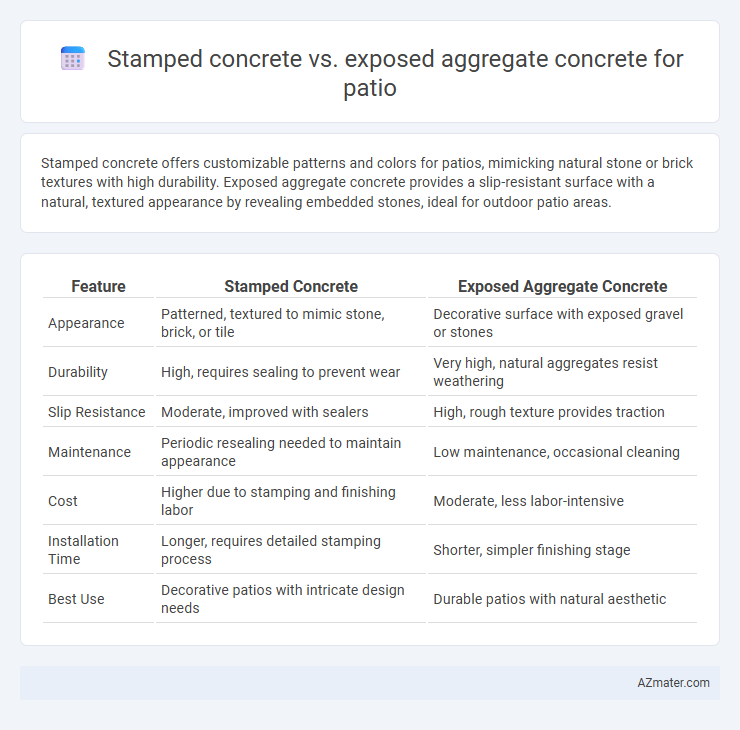Stamped concrete offers customizable patterns and colors for patios, mimicking natural stone or brick textures with high durability. Exposed aggregate concrete provides a slip-resistant surface with a natural, textured appearance by revealing embedded stones, ideal for outdoor patio areas.
Table of Comparison
| Feature | Stamped Concrete | Exposed Aggregate Concrete |
|---|---|---|
| Appearance | Patterned, textured to mimic stone, brick, or tile | Decorative surface with exposed gravel or stones |
| Durability | High, requires sealing to prevent wear | Very high, natural aggregates resist weathering |
| Slip Resistance | Moderate, improved with sealers | High, rough texture provides traction |
| Maintenance | Periodic resealing needed to maintain appearance | Low maintenance, occasional cleaning |
| Cost | Higher due to stamping and finishing labor | Moderate, less labor-intensive |
| Installation Time | Longer, requires detailed stamping process | Shorter, simpler finishing stage |
| Best Use | Decorative patios with intricate design needs | Durable patios with natural aesthetic |
Introduction to Stamped Concrete and Exposed Aggregate
Stamped concrete transforms plain concrete into intricate patterns and textures, often mimicking natural stone, brick, or tile, creating a visually appealing patio surface with high durability. Exposed aggregate concrete reveals the natural stone within the concrete mix by removing the top layer of cement paste, offering a slip-resistant, textured finish ideal for outdoor patios. Both options provide unique aesthetic and functional benefits, with stamped concrete emphasizing design versatility while exposed aggregate highlights natural texture and toughness.
Aesthetic Differences: Stamped vs Exposed Aggregate
Stamped concrete offers intricate patterns and textures that mimic natural stone, brick, or wood, providing a highly customizable and decorative patio surface. Exposed aggregate concrete reveals a rugged, natural stone finish by washing away the top cement layer, resulting in a durable and slip-resistant texture ideal for outdoor settings. Both options enhance aesthetic appeal, but stamped concrete suits formal, elegant designs while exposed aggregate complements rustic and natural aesthetics.
Installation Process Comparison
Stamped concrete installation involves pouring a base layer before imprinting patterns and textures with specialized stamps while the concrete is still pliable, requiring precise timing and skilled labor. Exposed aggregate concrete installation entails pouring a concrete slab followed by surface treatment to remove the top layer and reveal embedded aggregates, which demands careful washing and brushing techniques. Both methods require curing time and sealing, but stamped concrete generally requires more detailed craftsmanship for pattern accuracy and color application.
Durability and Longevity
Stamped concrete and exposed aggregate concrete both offer durable surfaces for patios, but their longevity varies due to surface texture and maintenance. Stamped concrete features a patterned, often coated finish that may require resealing every 2-3 years to prevent wear and cracking, while exposed aggregate concrete reveals embedded stones that provide a naturally slip-resistant and robust surface with less frequent sealing needed. Choosing between these options depends on desired aesthetic appeal combined with maintenance willingness, as exposed aggregate typically withstands heavy foot traffic and weather conditions longer without significant degradation.
Slip Resistance and Safety
Stamped concrete offers moderate slip resistance with its textured patterns mimicking natural stone or brick, but may become slippery when wet without added anti-slip treatments. Exposed aggregate concrete provides superior slip resistance due to its rough, naturally textured surface made from exposed small stones and pebbles, making it a safer choice for patios in wet or high-traffic areas. Choosing exposed aggregate concrete enhances safety by minimizing slip hazards while offering durable and visually appealing patio flooring.
Maintenance Requirements
Stamped concrete requires regular sealing every 2-3 years to maintain its color and prevent surface cracking, making routine cleaning and resealing essential for longevity. Exposed aggregate concrete has lower maintenance demands, needing only periodic washing to remove dirt and debris while its natural texture resists wear and staining without frequent sealing. Choosing between the two depends on the desired aesthetic and the willingness to commit to maintenance schedules for preserving surface appearance and durability.
Cost Comparison
Stamped concrete typically costs between $8 and $18 per square foot due to the intricate patterns and coloring techniques involved, making it a premium choice for patios. Exposed aggregate concrete ranges from $6 to $12 per square foot, offering a more affordable option with a textured, natural stone appearance. Labor and material costs for stamped concrete are higher because of the detailed stamping process, while exposed aggregate involves simpler finishing methods, reducing overall expenses.
Climate Suitability
Stamped concrete offers excellent durability and heat resistance, making it ideal for hot and dry climates where intense sunlight can cause surface damage. Exposed aggregate concrete provides superior slip resistance and performs well in wet or humid climates, as its textured surface minimizes water pooling and enhances traction. Both options are frost-resistant but choosing between the two depends on local climate factors such as temperature extremes and precipitation patterns for optimal patio longevity.
Design Versatility and Customization
Stamped concrete offers exceptional design versatility with the ability to mimic natural stone, brick, or wood patterns, allowing for extensive customization in texture, color, and layout to achieve highly detailed and intricate patio designs. Exposed aggregate concrete provides a distinct, textured surface by revealing decorative stones, offering customization primarily through the choice of aggregate size, color, and exposure level but with less intricate patterning than stamped concrete. Both options enhance patio aesthetics, but stamped concrete excels in replicating complex designs, while exposed aggregate emphasizes natural, tactile appeal.
Choosing the Right Finish for Your Patio
Choosing between stamped concrete and exposed aggregate concrete for your patio depends on desired aesthetics and durability. Stamped concrete offers intricate patterns and textures that mimic natural stone or brick, ideal for decorative appeal, while exposed aggregate concrete provides a textured, slip-resistant surface emphasizing natural stone finishes. Consider factors like maintenance, weather resistance, and budget to select a patio finish that enhances outdoor living spaces while meeting functional needs.

Infographic: Stamped concrete vs Exposed aggregate concrete for Patio
 azmater.com
azmater.com